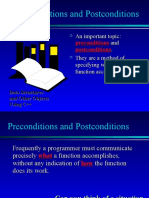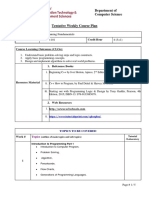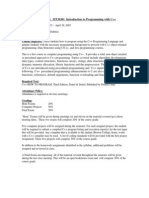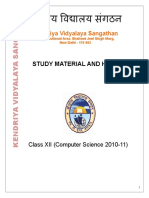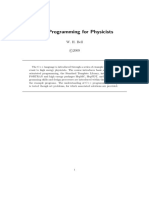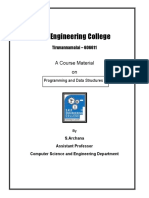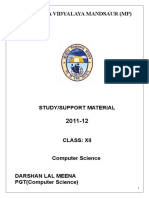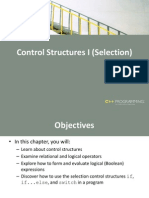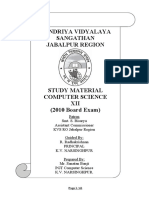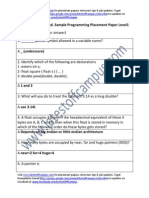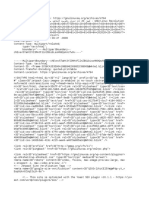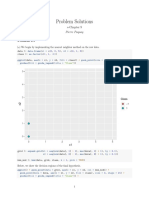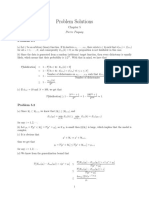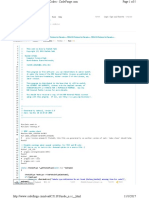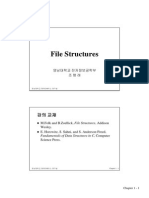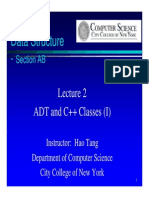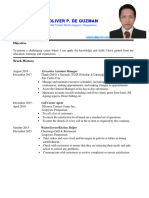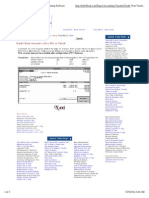CSC212
Data Structures
- Section AB
Lecture 1: Introduction
Instructor: Hao Tang
Tao Wang
Department of Computer Science
City College of New York
1
�Course Web Page
You can find all the information at
ccvcl.org/~tang/cs212.html
-Come back frequently for updates of lecture schedule,
programming assignments and exam schedule
- Reading assignments & programming assignments
�Outline of this lecture
Course Objectives and Schedule
WHAT (Topics)
WHY (Importance)
WHERE (Goals)
HOW (Information and Schedule)
The Phase of Software Development
Basic design strategy
Pre-conditions and post-conditions
Running time analysis
3
�Topics (WHAT)
Data Structures
specification, design, implementation and use of
OOP and C++
C++ classes, container classes , Big Three
Standard Template Library (STL)
basic data types (arrays, lists, queues, stacks, trees)
templates, iterators
ADTs in our DS course cut-down version of STL
Recursion, Searching and Sorting Algorithms
important techniques in many applications
4
�Importance (WHY)
Data Structures (how to organize data) and
Algorithms (how to manipulate data) are the cores of
todays computer programming
The behavior of Abstract Data Types (ADTs) in our
Date Structures course is a cut-down version of
Standard Template Library (STL) in C++
Lay a foundation for other aspects of real
programming OOP, Recursion, Sorting, Searching
5
�Goals (WHERE)
understand the data types inside out
Implement these data structures as classes in C++
Determine which structures are appropriate in
various situations
Confidently learn new structures beyond what is
presented in this class
also learn part of the OOP and software
development methodology
�Course Information (HOW)
Objectives
Data Structures, with C++ and Software Engineering
Textbook and References
Texbook: Data Structures and Other Objects Using C++ , Third Edition by Michael Main
Prerequisites
CSc102 C++ (Intro to Computing), CSc 104 (Discrete Math Structure I)
Assignments and Grading
and Walter Savitch
Reference: C++ How to Program by Dietel & Dietel, 3rd Ed., Prentice Hall 2001
6-7 programming assignments roughly per weeks (30%)
3 in-class written exams (60%), several in-class quizzes (10%)
Computing Facilities
PCs: Microsoft Visual C++ ; Unix / Linux : g++; MinGW; codeblocks(free)
also publicly accessible at Computer Science labs
7
�Tentative Schedule (HOW)
(28 classes = 22 lectures + 3 reviews + 3 exams + 6-7 assignments)
Lecture 1.
The Phase of Software Development (Ch 1)
Lectures 2-3. ADT and C++ Classes (Ch 2)
Lecture 4-5.
Container Classes (Ch 3)
Lectures 6-8. Pointers and Dynamic Arrays (Ch 4)
Reviews and the 1st exam (Ch. 1-4)
Lectures 9-10. Linked Lists (Ch. 5)
Lectures 11. 11a. Template and STL (Ch 6)
Lecture 12.
Stacks (Ch 7) and Queues (Ch 8)
Lectures 13-14. Recursion (Ch 9)
Reviews and the 2nd exam (Ch. 5-9)
Lectures 15-18. Trees (Ch 10, Ch 11)
Lectures 19-20. Searching and Hashing (Ch 12)
Lectures 21- 22. Sorting (Ch 13)
Lecture 23. Graphs (Ch 15)
Reviews and the 3rd exam (mainly Ch. 10-13, ~July 23 or 24)
8
�Tentative Schedule (cont.)
Exams
Whole
class
Quizzes
5-15
minutes in class
Talks
(not directly related to DS, but help
you to broaden your vision)
Guests
from Vision & Robotics lab and outside
CCNY
Topics including Machine Learning, Computer
Vision, HCI, Robotics and Visualization.
�Outline
Course Objectives and Schedule
Information
Topics
Schedule
The Phase of Software Development
Basic design strategy
Pre-conditions and post-conditions
Running time analysis
10
�Phase of Software Development
Basic Design Strategy four steps (Reading: Ch.1 )
Specify the problem - Input/Output (I/O)
Design data structures and algorithms (pseudo code)
Implement in a language such as C++
Test and debug the program (Reading Ch 1.3)
Design Technique
Decomposing the problem
Two Important Issues (along with design and
Implement)
Pre-Conditions and Post-Conditions
Running Time Analysis
11
�Preconditions and Postconditions
An important topic: preconditions and
postconditions.
They are a method of specifying what a
function accomplishes.
Precondition and Postcondition Presentation copyright 1997, Addison Wesley Longman
For use with Data Structures and Other Objects Using C++ by Michael Main and Walter Savitch.
12
�Preconditions and Postconditions
Frequently a programmer must communicate
precisely what a function accomplishes,
without any indication of how the function
does its work.
Can you think of a situation
where this would occur ?
13
�Example
You are the head of a
programming team
and you want one of
your programmers to
write a function for
part of a project.
HERE ARE
THE REQUIREMENTS
FOR A FUNCTION THAT I
WANT YOU TO
WRITE.
I DON'T CARE
WHAT METHOD THE
FUNCTION USES,
AS LONG AS THESE
REQUIREMENTS
ARE MET.
14
�What are Preconditions and
Postconditions?
One
way to specify such requirements is
with a pair of statements about the function.
The precondition statement indicates what
must be true before the function is called.
The postcondition statement indicates what
will be true when the function finishes its
work.
15
�Example
void write_sqrt( double x )
// Precondition: x >= 0.
// Postcondition: The square root of x has
// been written to the standard output.
...
16
�Example
void write_sqrt( double x)
// Precondition: x >= 0.
// Postcondition: The square root of x has
// been written to the standard output.
The precondition and
postcondition appear as
comments in your program.
They are usually placed after the
functions parameter list.
...
17
�Example
void write_sqrt( double x)
// Precondition: x >= 0.
// Postcondition: The square root of x has
// been written to the standard output.
In this example, the precondition
requires that
x >= 0
be true whenever the function is
called.
...
}
18
�Example
Which of these function calls
meet the precondition ?
write_sqrt( -10 );
write_sqrt( 0 );
write_sqrt( 5.6 );
19
�Example
Which of these function calls
meet the precondition ?
write_sqrt( -10 );
write_sqrt( 0 );
write_sqrt( 5.6 );
The second and third calls are fine, since
the argument is greater than or equal to zero.
20
�Example
Which of these function calls
meet the precondition ?
write_sqrt( -10 );
write_sqrt( 0 );
write_sqrt( 5.6 );
But the first call violates the precondition,
since the argument is less than zero.
21
�Example
void write_sqrt( double x)
// Precondition: x >= 0.
// Postcondition: The square root of x has
// been written to the standard output.
The postcondition always indicates
what work the function has
accomplished. In this case, when
the function returns the square root
of x has been written.
...
22
�Another Example
bool is_vowel( char letter )
// Precondition: letter is an uppercase or
// lowercase letter (in the range 'A' ... 'Z' or 'a' ... 'z') .
// Postcondition: The value returned by the
// function is true if letter is a vowel;
// otherwise the value returned by the function is
// false.
...
23
�Another Example
What values will be returned
by these function calls ?
is_vowel( 'A' );
is_vowel(' Z' );
is_vowel( '?' );
24
�Another Example
What values will be returned
by these function calls ?
is_vowel( 'A' );
is_vowel(' Z' );
is_vowel( '?' );
true
false
Nobody knows, because the
precondition has been violated.
25
�Consequence of Violation
Who is responsible for the crash ?
write_sqrt(-10.0);
is_vowel( '?' );
Bring up Slide Notes!!!
Violating the precondition
might even crash the computer.
26
�Always make sure the
precondition is valid . . .
The programmer who
calls the function is
responsible for
ensuring that the
precondition is valid
when the function is
called.
AT THIS POINT, MY
PROGRAM CALLS YOUR
FUNCTION, AND I MAKE
SURE THAT THE
PRECONDITION IS
VALID.
27
�. . . so the postcondition becomes
true at the functions end.
The programmer who
writes the function counts
on the precondition being
valid, and ensures that the
postcondition becomes
true at the functions end.
THEN MY FUNCTION
WILL EXECUTE, AND WHEN
IT IS DONE, THE
POSTCONDITION WILL BE
TRUE.
I GUARANTEE IT.
28
�A Quiz
The famous skyline was
dark on Aug 14th, 2003.
Suppose that you call a
function, and you neglect to
make sure that the
precondition is valid.
Who is responsible if this
inadvertently causes a 1-day
long blackout in NYC or
other disaster?
You
The programmer who
wrote that Power
Supply function
Mayor Bloomberg
Outside of Penn Station
29
�A Quiz
Suppose that you call a
function, and you neglect to
make sure that the
precondition is valid.
Who is responsible if this
inadvertently causes a 1-day
long blackout in NYC or
other disaster?
You
The programmer who
calls a function is
responsible for
ensuring that the
precondition is valid.
Outside of Penn Station
30
�On the other hand, careful
programmers also follow these rules:
When
you write a function, you should
make every effort to detect when a
precondition has been violated.
If you detect that a precondition has been
violated, then print an error message and
halt the program.
31
�On the other hand, careful
programmers also follow these rules:
When
you write a function, you should
make every effort to detect when a
precondition has been violated.
If you detect that a precondition has been
violated, then print an error message and
halt the program...
...rather than causing
a chaos.
The famous skyline was
dark on Aug 14th, 2003.
32
�Example
void write_sqrt( double x)
// Precondition: x >= 0.
// Postcondition: The square root of x has
// been written to the standard output.
{
assert(x >= 0);
...
The assert function
(described in Section 1.1) is
useful for detecting violations
of a precondition.
33
�Advantages of Using Pre- and Post-conditions
Concisely
describes the behavior of a
function...
... without cluttering up your thinking with
details of how the function works.
At a later point, you may reimplement the
function in a new way ...
... but programs (which only depend on the
precondition/postcondition) will still work
with no changes.
34
�Break
35
�Summary of pre- and post-conditions
Precondition
The programmer who calls
a function ensures that the
precondition is valid.
The programmer who
writes a function can bank
on the precondition being
true when the function
begins execution.
Postcondition
The programmer
who writes a
function ensures
that the
postcondition is
true when the
function finishes
executing.
36
�Phase of Software Development
Basic Design Strategy four steps (Reading: Ch.1 )
Specify Input/Output (I/O)
Design data structures and algorithms
Implement in a language such as C++
Test and debug the program (Reading Ch 1.3)
Design Technique
Decomposing the problem
Two Important Issues (along with design and
Implement)
Pre-Conditions and Post-Conditions
Running Time Analysis
37
�Running Time Analysis Big O
Time
Analysis
Fast enough?
How much longer if input gets larger?
Which among several is the fastest?
38
�Example : Stair Counting Problem
How many steps ?
1789 (Birnbaum)
1671 (Joseph Harriss)
1652 (others)
1665 (Official Eiffel Tower Website)
Find
it out yourself !
Eiffel Tower
39
�Example : Stair Counting Problem
Find it out yourself !
Method
1: Walk down and keep
a tally
Each time a step down, make a mark
Method
2 : Walk down, but let
Judy keep the tally
There
II
y a are
2689
2689
2689
steps in
marches
this
dan
cet
stairway
escalier
_______
_______
______
!
vraiment!
(really!)
Down+1, hat, back, Judy make a mark
Method
3: Jervis to the rescue
One mark per digit
Eiffel Tower
40
�Example : Stair Counting Problem
How to measure the time?
Just measure the actual time
varies from person to person
depends on many factors
Count
certain operations
each time walk up/down, 1
operation
each time mark a symbol, 1
operation
Eiffel Tower
41
�Example : Stair Counting Problem
Find it out yourself !
Method
1: Walk down and keep a tally
2689 (down) + 2689 (up) + 2689 (marks)
= 8067
Method
2 : Walk down, let Judy keep tally
Down: 3,616,705 = 1+2++2689
Up:
3,616,705 = 1+2++2689
Marks:
Method
7,236,099 !
2,689 = 1+1++1
3: Jervis to the rescue
only 4 marks !
Eiffel Tower42
�Example : Stair Counting Problem
Size
of the Input : n
Method
1: Walk down and keep a tally
3n
Method
2 : Walk down, let Judy keep tally
n+2(1+2++n) = n+(n+1)n = n2+2n
Trick: Compute twice the amount
and then divided by two
Method
3: Jervis to the rescue
The number of digits in n = [log10 n]+1
Eiffel Tower43
�Example : Stair Counting Problem
Big-O
Notation the order of the algorithm
Use
the largest term in a formula
Ignore the multiplicative constant
Method
1: Linear time
3n => O(n)
Method
2 : Quadratic time
n2+2n => O(n2)
Method
3: Logarithmic time
[log10 n]+1 => O(log n)
Eiffel Tower44
�A Quiz
Number of operations
Big-O notation
n2+5n
O(n2)
100n+n2
O(n2)
(n+7)(n-2)
O(n2)
n+100
O(n)
number of digits in 2n
O(log n)
45
�Big-O Notation
The
order of an algorithm generally is more
important than the speed of the processor
Input size: n O(log n)
O (n)
O (n2)
# of stairs: n [log10n]+1
3n
n2+2n
10
30
120
100
300
10,200
1000
3000
1,002,000
46
�Time Analysis of C++ Functions
Example- Quiz ( 5 minutes)
Printout all item in an integer array of size N
for (i=0; i< N; i++ )
{
val = a[i];
cout << val;
}
2 C++
operations or
more?
Frequent linear pattern
A loop that does a fixed amount of operations N times
requires O(N) time
47
�Time Analysis of C++ Functions
Another example
Printout char one by one in a string of length N
for (i=0; i< strlen(str); i++ )
{
c = str[i];
cout << c;
}
2
O(N )!
What is a single operation?
If the function calls do complex things, then count the
operation carried out there
Put a function call outside the loop if you can!
48
�Time Analysis of C++ Functions
Another example
Printout char one by one in a string of length N
N = strlen(str);
for (i=0; i<N; i++ )
{
c = str[i];
cout << c;
}
O(N)!
What is a single operation?
If the function calls do complex things, then count the
operation carried out there
Put a function call outside the loop if you can!
49
�Time Analysis of C++ Functions
Worst case, average case and best case
search a number x in an integer array a of size N
for (i=0; (i< N) && (a[i] != x); i++ );
if (i < N) cout << Number << x << is at location << i << endl;
else cout << Not Found! << endl;
Can you provide an exact number of operations?
Best case: 1+2+1
Worst case: 1+3N+1
Average case: 1+3N/2+1
50
�Testing and Debugging
Test: run a program and observe its behavior
Choosing Test Data : two techniques
input -> expected output?
how long ?
software engineering issues
boundary values
fully exercising code (tool: profiler)
Debugging find the bug after an error is found
rule: never change if you are not sure whats the error
tool: debugger
51
�Summary
Often ask yourselves FOUR questions
WHAT, WHY, WHERE & HOW
Topics DSs, C++, STL, basic algorithms
Data Structure experts
Schedule 21 lectures, 7 assignments, 3 exams
some credits (10) for attending the class
Information website
Remember and apply two things (Ch 1)
Basic design strategy
Pre-conditions and post-conditions
Running time analysis
Testing and Debugging (reading 1.3)
52
�Reminder
Lecture 2: ADT and C++ Classes
Reading Assignment before the next lecture:
Chapter 1
Chapter 2, Sections 2.1-2.3
Office Hours: Mon, Wed 12 am 1 pm
(location: NAC 8/210)
53
�Question and Survey
No
name!
Once
you finish, fold the paper.
54
�THE END
55


